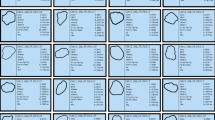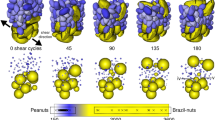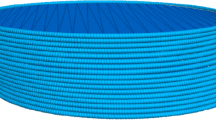Abstract
THE segregation of particles with different properties is important is many areas of science and technology, including materials science, engineering, agriculture and geophysics. In many segrega-tion processes the most important property of the particles is their size. Processes such as pouring, shaking, vibration, shear and fluidization lead to size segregation; in some cases it is found to occur even in processes developed for particle mixingM1. Because of its practical importance, particle segregation has been studied extensively during the past few decades2, and several two-dimensional models have been developed recently3–6. Here we describe results obtained from a simple three-dimensional simula-tion in which spheres are added, one at a time, to a growing heap on an infinite planar surface or within a cylinder of finite radius. In this model, size segregation is a consequence of the ability of large spheres to roll over a random packing of smaller spheres. Our results show that the degree of segregation is sensitive to both the size ratio and the number ratio for the case of a binary mixture of spheres.
This is a preview of subscription content, access via your institution
Access options
Subscribe to this journal
Receive 51 print issues and online access
$199.00 per year
only $3.90 per issue
Buy this article
- Purchase on SpringerLink
- Instant access to full article PDF
Prices may be subject to local taxes which are calculated during checkout
Similar content being viewed by others
References
Weidenbaum, S. S. & Bonilla, C. F. Chem. Engng Progr. 51, 27/J–36/J (1955).
Williams, J. C. Powder Technol. 15, 245–251 (1976).
Haff, P. K. & Werner, B. T. Powder Technol. 48, 239–245 (1986).
Rosato, A., Prinz, F., Standburg, K. J. & Swendsen, R. Powder Technol., 49, 59–69 (1986).
Rosato, A., Standburg, K. J., Prinz, F. & Swendsen, R. H. Phys. Rev. Lett. 58, 1038–1040 (1987).
Meakin, P. Physica (in the press).
Visscher, W. T. & Bosterli, M. Nature 239, 504–507 (1972).
Jullien, R. & Meakin, P. Europhys. Lett. 6, 629–634 (1988).
Rodiquez, J., Allibert, C. H. & Chaix, J. M. Powder Technol. 47, 25–33 (1986).
Bridgewater, J., Sharpe, N. W. & Stocker, D. C. Trans. Inst. Chem. Engng 47, T114–T119 (1969).
Bridgewater, J. Powder Technol. 15, 215–236 (1976).
Scott, A. M. & Bridgewater, J. Ind. Engng Chem. Fundam. 14, 22–27 (1975).
Bridgewater, J., Foo, W. S. & Stephens, D. J. Powder Technol. 41, 147–158 (1985).
Bridges, E. M. World Soils (Cambridge University Press, 1970).
Bagnold, R. A. The Physics of Blown Sand and Desert Dunes (Chapman and Hall, London, 1941).
Sallenger, A. H. J. sedim. Petrol. 49, 553–562 (1979).
Baeyens, J. & Geldart, D. in Gas Fluidization Technology (ed. Geldart, D.) 97 (Wiley, Chichester, 1986).
Author information
Authors and Affiliations
Rights and permissions
About this article
Cite this article
Jullien, R., Meakin, P. A mechanism for particle size segregation in three dimensions. Nature 344, 425–427 (1990). https://doi.org/10.1038/344425a0
Received:
Accepted:
Issue date:
DOI: https://doi.org/10.1038/344425a0
This article is cited by
-
Residual Defect Density in Random Disks Deposits
Scientific Reports (2015)
-
Analysis of the packing structure of wet spheres by Voronoi–Delaunay tessellation
Granular Matter (2007)
-
Size separation of granular particles
Nature (2001)
-
Mixed predictions
Nature (1995)



